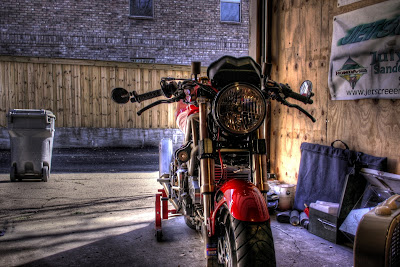Its been awhile since I've updated last. Lots of things have changed included the abilities of the rider. I'm working more closely with a local shop on different abilities, which coincides nicely with the just begun WorldSBK season, and the upcoming MotoGP season. (I do also regularly watch the AMA races, but thanks to DVR, I seem to put them off until lazy afternoons and don't really keep up with that league in real-time).
The bike has been taken apart for a bit after getting some good miles on fair-weather days in the late-winter/early spring. The weather in DFW is funny and quite unpredictable. It dumped snow recently, without much prediction, and was 70 degrees outside shortly before, and shortly after that weekend.
The bike is having bungs welded to the exhaust headers so a fuel/air ratio monitor can be easily attached to aid in tuning. After the welding is complete, the headers are being shipped off to be coated by Jet Hot, along with the intake flanges. The principle behind ceramic coating is quite simple and something I enjoyed working as an undergraduate in Fluid/Thermal Systems.
To simplify, A biker wants the exhaust to get out of the motor, and out of the pipes quickly, for performance reasons. Similarly, a biker does not like getting burnt by the heat coming off the exhaust pipes. And lastly, if a biker can keep the bike's ambient temperature down, he can extract a little more performance all around (from cooler fuel, to easier engine cooling, etc).
Ceramic coating benefits all of the above. In a standard setup, the expelled exhaust gases are free to lose heat through the walls of the exhaust, evident if you've ever grabbed a hot exhaust pipe or, worse, header pipe. The exhaust gases cool as exhaust gas loses heat to the metal, and then to the ambient air. This cooler gas becomes more dense and moves more slowly. If the pipes were insulated, via exhaust wrap or ceramic coating, the exhaust gas would be less able to release heat before exiting the pipe. Good for performance, good for your extremities which get too close on occasion, and good for keeping radiant heat down.
The ceramic coating process, in its preferred form, adds the coating to both the inside and outside of the pipe. The intake manifolds, those which connect the carburettors to the cylinder intakes, are also being coated. Instead of keeping the heat in those pipes, as the goal is for ceramic coated exhaust, the goal is to keep the heat out of the intake air. A cooler, denser intake air increases performance of the motor as well.
While everything is apart, the carbs have been pulled to be thoroughly cleaned, and since the fuel lines and vacuum hoses all around have been on the bike for well over 5-years each, its time they be replaced. While the lines are being replaced, I took the opportunity to remove the vacuum petcock system and replace with a good old fashioned fuel valve. No more risk of vacuum troubles arising from the petcock's failure, it's related hose failure, and a cleaner look all the way around. The fuel pump needed rebuilt as its the original from 1999 (likely put on the bike in 1998 during assembly and sitting on the shelf for who-knows how long before that). Chris Kelley of CA-Cycleworks sells a convenient, inexpensive vacuum operated Mikuni replacement that is rectangular to replace the vacuum operated Mikuni pentagon shaped pump. The great bonus with the replacement fuel pump is that its cost is the same as the rebuild kit!
The fuel supply line is now run around the left (alternator) side of the bike, rather than in front of the vertical cylinder belt cover. To keep heat away from the fuel line and fuel inside, the lines have been insulated with Heatshield Products heatwrap (Builders Kits) or the similar material from McMaster-Carr.
The idea of putting everything back together, only to bolt up the OEM Mikuni 38 CV carbs is perhaps a little much. This may be the easiest opportunity to bolt up a set of Keihin FCR-41s that I'll have, and with my recent carbon fiber fabrication (thanks unofficially to friends at Lockheed), I could also make a new battery box and coil bracket, and go to the more attractive (though debatable/negligibly worse performing) pod filters. The next question that would arise is... K&N Pods or UNI Filters?

